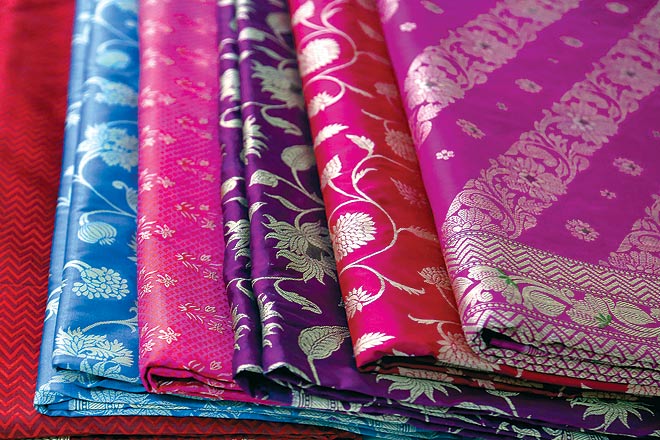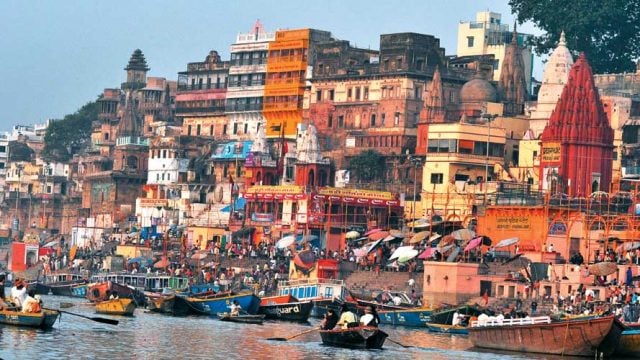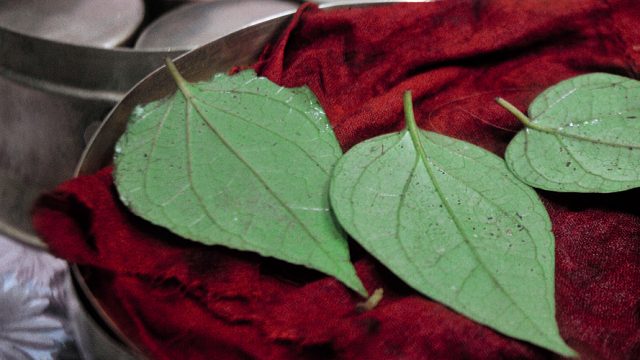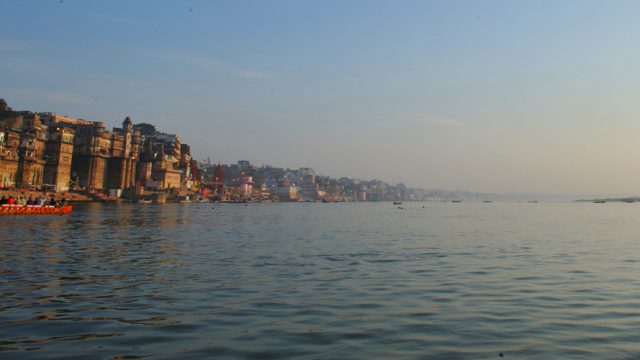On the very first day of my pursuit of the authentic high-quality Banarasi sari, the conversation has
At the Taj Nadesar Palace, the stage is set for the exploration of something oh-so-refined and delicate as a handcrafted Banarasi. Amid a velvety 28 acres, the white colonial mansion built by James Prinsep for the British Resident in 1835 stands with poise. It later became the city home of the royal family of Banaras, gently fading away till the Taj group restored it and made a boutique hotel here in 2009. We are among the collateral beneficiaries.
There are only 10 suites here, and mine is the Queen Elizabeth suite. Her Majesty once stayed here – as her really young presence in the photographs hanging on the walls attests. Other suites are named after the crème-de-la-crème that occupied them: I note Lord Mountbatten and Pt Nehru, among others. Peacocks roam the serene lawns, organic and luscious langda mangoes grown on the grounds are served for breakfast, and the graceful proportions of the building resonate with live bansuri, which is played in the evenings. You can sink into antique armchairs in the balcony and watch the birds, or lounge next to the swimming pool and discuss the delectable menu in enthusiastic detail with the chefs; and at the end of a hectic day of sightseeing you can surrender to the bath tub – can’t miss it, it’s huge, and at night they strew rose petals in your room leading to it. The suites – with their antique fans, chandeliers, and four-poster beds – are big enough for a small morning walk, but the fresh mornings invite you outside. And here you can take a little horse-buggy ride, regaled with ye olde stories of royalty by a traditional gaadivaan.
Staying at the Nadesar Palace comes with the luxury of being chaperoned around the city by knowledgeable guides. This usually includes the famous Ganga aarti, the old city lanes and temples, but in our case this means the managers work out a list of respected high-end shops that I must see. Aided by the Taj’s able guides, and by Banarasi friends whose mothers have been buying saris here for generations, I plunge into the warp and weft of the sari business.
They have been weaving in the subcontinent since at least the time of the Rig Veda. The famous Creation Hymn describes creation as an act of weaving: “Weave forward, weave backward, they say, as they sit by the loom stretched tight. The man stretches the warp and draws the weft. The man has spread it out upon this dome of the sky. These are the pegs that are fastened in place. They made the Sama melodies into shuttles for weaving.”
Seen from the outside, Banaras seems like the microcosm of this tradition. It became a hub of weavers during Mughal times, when craftsmen migrated here from Persia. It saw rich traditions like kimkhwab (little dream) emerge, in which you could hardly see the silk for the zari. The famous Banaras brocade became a byword for European luxury and the Banarasi sari a must for North Indian brides. Today, its many thousands of weavers churning out Banarasi saris, with their trademark patterns of paisley, geometrical motifs, or hunting scenes are all caught up in a storm of handloom vs powerloom, dying techniques, migrating weavers, fake Banarasis with plastic ‘zari’ made on Chinese silk, and attempts at revival. And the fact of a heavy Banarasi handloom selling for Rs 1.50 lakh in the prime markets of Delhi and Mumbai.
The reality is this: no connoisseur actually goes to Banaras to buy a genuine Banarasi over the counter from a retail shop. Nearly all showrooms in the city are a nightmare of red and bling. The real work is done by the gaddidars, the wholesale operators who have emerged from a family tradition of weaving. The gaddidars constitute an experience to be savoured: classic white sheets and bolsters spread across the whole room, sitting on the floor, a choice of lassi or tea, or anything Banarasi you care to ask for… before the business of unfurling and discussing the saris begins.
They are at pains to point out that they are not ‘traders’ but manufacturers. They have their own set-up of weavers, master weavers, designers, and they supply their own materials, taking responsibility for its authenticity. Silk, organza, net, cotton…, jaamdani, tassar, rangkaadh, shikargah, kadhua… silver work, gold zari… heavy and light, delicate and ‘fancy’, the whole range of what Banaras has to offer is rolled out to stun the senses.
But they don’t really deal with individual customers. Wholesale buyers from Mumbai, Delhi, Kolkata, and Chennai throng these vast establishments, which are well-known names in the traditional Chowk area of Banaras: SND (Shah Narayan Das), JDS, Nilambari Saris, and Ushnaq Mal. Your average retail buyer would, of course, not be turned away; indeed, if you wish to buy 5-6 saris you will be entertained with grace and tea. But you will be conscious that their time may be better spent dealing with the long-term buyer who has come to place an order for 40 saris.
Some of the old-time Muslim master weavers are yet another gossamer tale. Having traversed the narrow lanes of the city’s old Peeli Kothi area, faced with the gentle Hasin Mohammad (“Hasin bhai”) as he offers me sewaiin seated on his old white gaddas, I’m hardly prepared for the litany of big names that proceed to season his conversation:
“My father worked a lot with Pupul Jayakar… Rajivji had come to get Indiraji’s wedding sari repaired… See this newspaper; Jayaji is wearing our sari… Arvind Singh Mewar’s daughter was getting married and they commissioned us to make this pattern but in that colour… Mrs Arun Singh called and said, watch that TV channel now, Soniaji is wearing your creation… Mrs Mittal came with a piece of grandmother’s sari and wanted it recreated… Rajesh Pratap Singhji has been sourcing from us for many years… Manish Aroraji gave us patterns to weave and I hardly recognised what the cloth had eventually ended up as…”
Dazzled, I ask, what is the most expensive sari he can think of making? Well… if it’s very intricate, and with real zari, maybe something to the tune of Rs 50,000.
Banarasi saris force you to reassess your idea of luxury. The Banarasi-specialist traders in the Chowk area have higher-end saris which they sell, wholesale, for upto Rs 75,000 or so. In the retail showrooms of the metros, these then sell for more than a lakh and up to Rs 2 lakh. And yet Hasin bhai — that old friend of royalty, political elite and upscale designers — has not once mentioned the word ‘lakh’.
The same is the case with another pillar of the old-school, master weaver and teacher: Haji Munna. Asked to show his signature work, he apologetically takes out an exquisite dull pink sari with a hint of delicate silver zari work, and lays it on another one in an ethereal almost-purple. I want to eat them up. “They may not be suitable for modern tastes,” he says. “Indeed, a buyer once told me ‘aap bahut soye soye rang istemaal karte hain, you use very sleepy colours’.” He tells me how his grandmother used the colours from the parijaat tree as dyes and how he has often dyed threads himself because natural colours give shades that cannot be reproduced by artificial dyes.
If these colours are sleepy, I can see that they are lost in the most pleasant of dreams, I say. He chuckles in appreciation. He supplies saris to Heritage Handloom Emporium in Delhi’s South Extension as well as the Cottage Emporium and Rs 40,000-50,000 is his higher limit as well.
The Mehta International Silk Centre comes with the unexpected luxury of watching and actually gaining some understanding of the intricate weaving process. The Mehta family is one of the relatively few Hindu families in the weaving business, and their patterns of Raas Leela mark a break from the Mughal-style Banarasi patterns that we have all come to recognise. It’s interesting to watch the jaala and jacquard looms in operation. Here you can see the difference between phenkua and kadhua: the technique of throwing (phenkna) the shuttle from end-to-end between the threads of the warp, and weaving in the threads (kadhna) one by one. Mehta also makes stoles, scarves, wall hangings and bedcovers. Indeed, a rich and intricate bedcover depicting the traditional nayikas is a piece that he refuses to sell since he considers it something of a family heirloom.
In addition to these establishments, Taj Estate at Bhelupura is almost universally accepted in Banaras as the go-to place which keeps a huge range and variety of stock, with some very heavy and intricate saris. This is mostly credited to the expertise and eye of Saleem Bhai, who as a young lad learnt weaving with his uncles, started by selling Banarasi woven cloth piece to traders in Delhi’s Chandni Chowk and worked his way up. A visit to Taj Estate comes with offers of tea and lassi and animated stories from Kaleem bhai (“jee, har sari par khareedne wale ka naam likha hota hai”).
How does the buyer recognise a real handloom-made Banarasi silk? I ask everyone I meet. Each answer I get has an inimitable Banarasi flavour to it. Textile expert Aruna Raman says, “Well… if you make me touch a sari in the deep dark of the night, I can still tell you if it’s authentic handwoven silk.” At JDS, a bright Mr Shah says, “You buy diamonds from a jeweller, don’t you? You have no way to test if it’s authentic, you just have to trust.” As for Haji Munna, he looks down at his frail and bent-shouldered form, clad in a simple kurta and lungi, and smiles, “Bhai, in my case, one look at me and people can tell that this man must be a handloom weaver….”
The information
Where to stay
The Taj Nadesar Palace (from Rs 35,000 doubles plus taxes, +91-542-6660002-06, tajhotels.com) is an impeccable gem in the riotous treasure house that is Varanasi and, currently, the only truly luxury property in the city. Its colonial-era heritage buildings and soothing grounds are a pleasure, and the fact that there are only 10 suites makes the place delightfully intimate. The food takes in ‘satvik’ Banarasi cuisine, sumptuous Maharaja thalis, pastas full of organic homegrown veggies, local sattu parathas, and the best fusion dahi-puri ever! Plus, anything else that you’d like to discuss with the chef. Activities include guided city tours, a golf course, a horse-carriage ride, and the Taj Group’s signature Jiva Spa.
The suites come with all expected amenities: mini-bar, wifi, tea/coffee-makers, ACs, TVs, bath tubs, rain showers, fruit platters… the works, along with some excellent hospitality that you’d expect from the group. Not to mention a personalised letter pad with your name on it, and your photograph that is framed and ready in your room by the time you check in!
The Taj Nadesar also carries out some worthy CSR activity in the weavers’ village of Sarai Mohana. Weavers had migrated en masse from here to look for work. The Taj supports the community by sponsoring 25 weavers, sourcing saris for its staff from them, running computer classes as well as weaving classes for the children, and providing solar panels and toilets.
Where to buy
Taj Estate, B-12/120 RS Gauriganj, Bhelupura, Varanasi (0542-2452228/ 9839055064). They supply to Kalpana in New Delhi.
Nilambari Saris, CK 39/74-76, Rajakatra Chowk, Varanasi (9415221270). They supply to L’Affaire in New Delhi. They also have retail outlets in Saket in New Delhi and Banjara Hills in Hyderabad.
JDS Exclusive, CK 19/16 Chowk, Varanasi (9336911581).
SND (Shah Narayan Das), CK 19/17, Chowk, Varanasi (9336904040). Their retail outlet is Ekaya in Defence Colony in New Delhi.
Mehta International Silk-Weaving Centre S 20/51, 3B, Varuna Bridge, Cantt Varanasi (0542-2505589).
HM Textiles (Hasin Muhammad), K 52, Dulligaddi (Behind Yamuna Talkies), Varanasi (9336960317). Make an appointment.
Haji Munna Creations, D 44/30-31, Reori Talaab, opp Haji Abbas Tani Wale, Varanasi (9889707675). They supply to Heritage in South Extension in New Delhi, and to Cottage Emporium in New Delhi. Make an appointment.
Benaras
Silk saris
Taj estate





